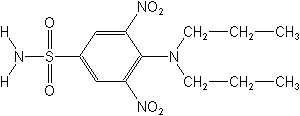-
Common NameOryzalin
-
中文通用名氨磺乐灵
-
IUPAC3,5-dinitro-N4,N4-dipropylsulfanilamide
-
CAS4-(dipropylamino)-3,5-dinitrobenzenesulfonamide
-
CAS No.19044-88-3
-
Molecular FormulaC12H18N4O6S
-
Molecular Structure
-
CategoryHerbicides > Dinitroaniline herbicides
Herbicides > Sulfonylurea Herbicides
Herbicides > Amide herbicides -
ActivityHerbicide
-
PremixAqueous suspension, dry flowable, wettable powder. Premix Parters: carbendazim cymoxanil thiram; copper oxychloride; cymoxanil mancozeb; folpet; mancozeb; propineb;
-
Physical PropertiesMolecular weight:346.4g/mol; Physical form:Tech. forms yellow-orange crystals. Composition:Tech is 98.3%. Melting point:141-142℃; ( tech., 138-143℃); Vapour pressure:<0.0013 mPa (25℃); Henry constant:<1.73 × 10-4 Pa m3 mol-1 (25 ℃, calc.); Partition coefficient(n-octanol and water):logP = 3.73 ( pH 7); pKa:9.4, v. weak acid; Solubility:In water 2.6 mg/l (25℃). In acetone >500, methyl cellosolve 500, acetonitrile >150, methanol 50, dichloromethane >30, benzene 4, xylene 2 (all in g/l, 25 ℃). Insoluble in hexane.; Stability:Stable under normal storage conditions. Does not hydrolyse in aqueous solution at pH 5, 7 or 9. Decomposed by u.v. irradiation; aqueous photolysis DT50 1.4 h in natural sunlight.;
-
ToxicologyOral:Acute oral LD50 for rats and gerbils >10 000, cats 1000, dogs >1000 mg/ kg. Percutaneous:Acute percutaneous LD50 for rabbits >2000 mg/kg. Slightly irritating to skin; non-irritating to eyes (rabbits). A skin sensitiser (guinea pigs). Inhalation: LC50 (4 h) for rats >3.1 mg/l air (nominal 4.8 mg/l).
-
Environmental ProfileEcotoxicology: Algae: ErC50 for Skeletonema costatum 45, Selenastrum capricornutum 51, Navicula sp. 87μg/l; ErC50 for Anabaena flos-aquaeBees: LD50 (oral) 25μg/bee; (contact) 11μg/bee.Birds:Acute oral LD50 for chickens >1000, bobwhite quail and mallard ducks >500 mg/kg. Dietary LC50 (5 d) >5000 mg/ kg.Daphnia: LC50 (48 h) 1.4 mg/l; NOEC (21 d) 0.61 mg/l.Fish: LC50 for bluegill sunfish 2.88, rainbow trout 3.26 mg/l. LC50 (96 h) for goldfish fingerlings >1.4 mg/l.Worms: NOEC (14 d) for earthworms >102.6 mg/ kg soil.Other aquatic spp.: EC50 (14 d) for Lemna gibba 0.015 mg/l, NOEC 0.006 mg/l. EC50 (shell deposition) for eastern oyster (Crassostrea virginica) 0.28 Environmental fate: Animals:In rats, elimination was virtually complete within 72 hours, c. 60% in faeces and 40% in urine. In rabbits, the ratio was reversed. Numerous metabolites have been detected in both urine and faeces. Biliary excretion accounted for a major portion Soil:In soil, microbial degradation occurs rapidly, aerobic metabolism being slower than anaerobic (DT50 1.2 mo and 10 d, respy., in the same soil). This involves dealkylation of the amine nitrogen, Plant:No oryzalin residues were detected in soya bean plants.
-
Transport InformationSignal Word:CAUTION; Hazard Class:III(Slightly hazardous)
Porduct NewsMore
Orthosulfamuron boosts sugarcane production, study finds
Glyphosate price plummets 40% in one year in Argentina
Indian govt stops imports of herbicide Glufosinate priced below Rs 1,289 per kg
Carbendazim fungicide wins victory in Brazilian Parliament
Corteva presents new pre-emergent herbicide Linear for sugarcane in Brazil
Picloram Triclopyr Aminopyralid
Revolutionizing disease prevention: BASF launches new rice fungicide Cevya® in China
Thiamethoxam is allowed again in Brazil by a judicial decision
Bayer develops alternative to glyphosate herbicide
Related CompaniesMore
Country: China
Metamitron Prochloraz Oryzalin Prodiamine Pendimethalin Glufosinate-ammonium Epoxiconazole Prothioconazole Dinotefuran
Hangzhou Tianlong Biotechnology Co., Ltd.
Country: China
Punjab Chemicals & Crop Protection Ltd.
Country: India

 0
0 Subscribe
Subscribe
